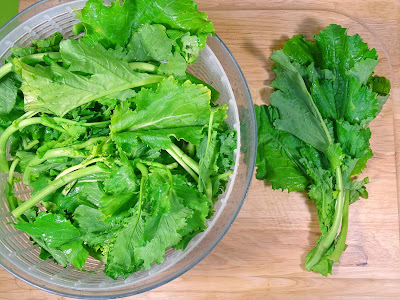While working on this dish, I started thinking about how many cloves of garlic I’ve chopped in my life. Surely thousands. And yet I’m not significantly better at it than ever. Not like those chefs who ninja their garlic in nanoseconds and turn out perfectly even, teeny-tiny dice. I watched a video posted by one of my food blogger friends, and it was truly impressive. I’m not going to give you the link because it would make me look bad, and that’s not what this blog is for. This blog is for making me look GOOD.
On the other hand, I heard Ruth Reichl (former editor of Gourmet) speak not long ago about her new cookbook, and she says she’s never had a cooking lesson, so her knife skills are hopeless. My kind of woman.
So in the run-up to Thanksgiving, we all need to be conserving our strength for the Herculean tasks to come. And as usual, the Kitchen Goddess is working on a few nice side dishes for you that will make veggies the star of the show. But in the meantime,...
Shakshuka! Sounds like someone sneezed, doesn’t it? Instead, it’s a terrific dish for a Sunday night supper or when you just want something straightforward that doesn’t dirty a bunch of bowls/pans. Conceptually, it’s a lot like a frittata in the sense that you can pump it up with whatever veggies you’ve got on hand, add some cheese, change the herbs, toss in some olives, etc. And it’s quite good reheated the next day for lunch.
At its most basic, shakshuka (also spelled shakshouka) is a dish of eggs poached in tomato sauce with onions, peppers, paprika, and cumin. It’s a staple of North African cuisines – Libyan, Tunisian, Algerian, Moroccan, and Egyptian – where it’s often served for breakfast; but it’s sufficiently hearty, especially with the various additions, that it’s also served at the evening meal, especially in winter. According to Wikipedia (who else?), shakshuka is also popular in Israel, where it was introduced by Tunisian Jews who immigrated there in the 1950s; and it’s strikingly similar to the Turkish dish, menemen.
So here’s the version the Kitchen Goddess served this week. What I liked most about it is the way the sweetness of the caramelized onions and peppers balanced with the bitterness of the broccoli rabe and the goat cheese. And my hubby sneaked a second helping when I wasn’t looking. So try mine or see what’s in your fridge that’ll make it your own.
Kitchen Goddess note: Broccoli rabe – pronounced rahb – is a relatively bitter green, more popular in Italy than the U.S., but it has gained popularity over the last few years. Its use in France goes back to the 16th century. As you might expect, it’s packed with vitamins and cancer-fighting agents. It’s also a good source of protein, and one of the best sources of vitamin K, which protects against osteoporosis.
This is a “saucy” dish, so you’ll want to serve it with something to sop up the juices – a crusty sourdough, pita, and naan all come to mind. It’s a one-dish meal, so you won’t need anything else.
Shakshuka with Goat Cheese and Broccoli Rabe
Adapted from Melissa Clark in The New York Times.
Serves 4.
 |
| Broccoli rabe |
3 tablespoons olive oil
1 large onion, halved and thinly sliced
1 large red bell pepper, halved, seeded, and thinly sliced
1 tablespoon tomato paste
1-2 teaspoons minced garlic
1½ teaspoons ground cumin
1 teaspoon sweet paprika (option: smoky paprika or a combination)
½ teaspoon Aleppo pepper (or ⅛ teaspoon cayenne pepper)
1 28-ounce can of whole plum tomatoes, with juice, coarsely chopped [Kitchen Goddess note: You can chop the tomatoes before adding them to the skillet, or add them to the skillet and chop them there, or use a potato masher on them. Or buy canned chopped tomatoes. The KG likes her tomatoes to be less uniformly chopped, but then you knew she would.]
4 ounces fresh goat cheese, crumbled
¾ teaspoon kosher salt
¼ teaspoon freshly ground black pepper
6 large eggs
Optional garnishes: chopped Italian parsley and chopped cilantro, hot sauce
 |
| Mise en place -- this recipe is a lot easier if you have everything ready. |
Directions
Bring a pot of well-salted water to a boil and drop in your broccoli rabe for 5 minutes. Drain it well and chop it into pieces about an inch long. Reserve.
Preheat the oven to 375º.
Put a large, oven-proof skillet over medium/medium-low heat and add the olive oil. Add the onion and bell pepper and cook, stirring frequently, about 15 minutes. You want the vegetables to soften, and for the onions to get golden, not brown. Stir in the tomato paste and the garlic, and continue to cook, stirring, another minute. Add the cumin, paprika, and Aleppo pepper, and continue to cook, stirring, another minute.
Stir in the chopped tomatoes with their juices. Simmer the mixture for 10 minutes, stirring occasionally, until tomatoes have thickened. Add the crumbled goat cheese and stir. (It’s okay if the goat cheese isn’t thoroughly mixed. Mix it as much as you’d like.) Taste the sauce for seasoning.
With a spoon, hollow out a small area in the sauce, about an inch from the edge of the skilllet, and crack an egg into it. Do the same with the remaining eggs, spacing the eggs evenly around the skillet. Season the eggs lightly with salt and pepper.
Transfer the skillet to the oven and cook at 375º for 7-9 minutes, depending on how runny you like your eggs. Sprinkle with parsley and cilantro.
 |
| Oops! I forgot the parsley and cilantro. Ah, well... |
Serve with hot sauce and some type of bread. The Kitchen Goddess recommends crusty sourdough, naan, or other flatbread.




No comments:
Post a Comment